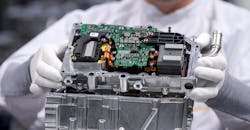As Chip Shortage Drags on, One Sector’s Pain is Another’s Gain
This article is part of TechXchange: Chip Shortages and Counterfeits.
In addition to ramping up more production capacity in the U.S., Texas Instruments is reallocating its resources help bring some relief to the automotive and industrial markets still being hit by chip shortages.
The company on Tuesday said its revenue in the second quarter jumped by 14% to $5.2 billion as shipments improved thanks to the easing of supply bottlenecks and ongoing demand for chips used in cars and on factory floors.
It also said third-quarter revenue would grow about 10% in the range of $4.90 billion to $5.30 billion, helping to assuage fears over hurting demand from a slowing economy and a glut of semiconductors on the market.
According to TI, the second quarter started off slow due to the fallout from factory lockdowns in China, which it previously warned would hamper its customers. But orders improved at the end of the second quarter as some of the lockdowns lifted and factories were able to start taking component deliveries once again. Net profit came out to $2.29 billion in the second quarter, up 19% from a year ago, or $2.45 per share.
Executives said demand for its analog and other chips is still surpassing its ability to supply them. The company is currently holding about 125 days of inventory, while it generally wants to have 190 days on hand.
Sales of analog and power-management chips and embedded processors used in cars soared by more than 20% in the second quarter, said TI. Demand from the industrial market was up in the high-single digits.
TI said it saw—and will continue to see—weakness in the consumer market, such as PCs and smartphones, where demand has dipped due to economic woes, inventory pileups, and rising prices for consumer goods.
Fungible Production
But one industry’s pain is another’s gain: Executives said TI's internal production capacity is “fungible,” meaning it can reallocate its resources—relatively quickly—from weak markets to those where demand remains strong.
“We do that constantly,” said Rafael Lizardi, TI’s chief financial officer, on a conference call Tuesday with investors. “The capacity is relatively fungible. There are always some nooks and crannies that are a little different for each technology or each particular part. But at the highest level, we have been adjusting our capacity over the last two months to deploy it to the best uses and support our long-term roadmap.”
The chip shortage has gripped the electronics sector for about two years at this point, caused by booming demand for electronic goods such as PCs and game consoles. Snarled supply chains are adding to delays. The scarcity of chips has led to widespread disruptions, snagging production of everything from medical to consumer devices, and car companies unable to buy chips to shut down factories. Chip prices are also rising due to raw material shortages.
The most acute shortages are in TI’s competitive wheelhouse: analog and power-management ICs. These chips are based on legacy technology that lags generations behind the most advanced chips on the market.
TI is the world’s largest maker of analog semiconductors and a major player in embedded processors such as microcontrollers (MCUs) that are vital to a wide swath of electronic devices from machinery on factory floors to washing machines, smartphones, and other consumer goods. A prolonged chip shortage has helped propel the company’s market value to over $158 billion, rivaling industry leaders Intel and Qualcomm.
TI sells tens of thousands of different chips to more than 100,000 customers around the world that represent virtually every part of the economy, turning it into a bellwether for the broader electronics market.
About 80% of the company’s chips are manufactured in-house at its fabs, and it plans to invest at least $2.5 billion in 2022 to build out those factories to close the demand gap in the short term as the chip shortage continues to grip the world.
TI said that it wants to bring even more production capacity in-house in the future to give it the upper hand on rivals, which tend to lean more on chip foundries that have been flooded with orders during the pandemic.
This article is part of TechXchange: Chip Shortages and Counterfeits.
About the Author
James Morra
Senior Editor
James Morra is the senior editor for Electronic Design, covering the semiconductor industry and new technology trends, with a focus on power electronics and power management. He also reports on the business behind electrical engineering, including the electronics supply chain. He joined Electronic Design in 2015 and is based in Chicago, Illinois.

